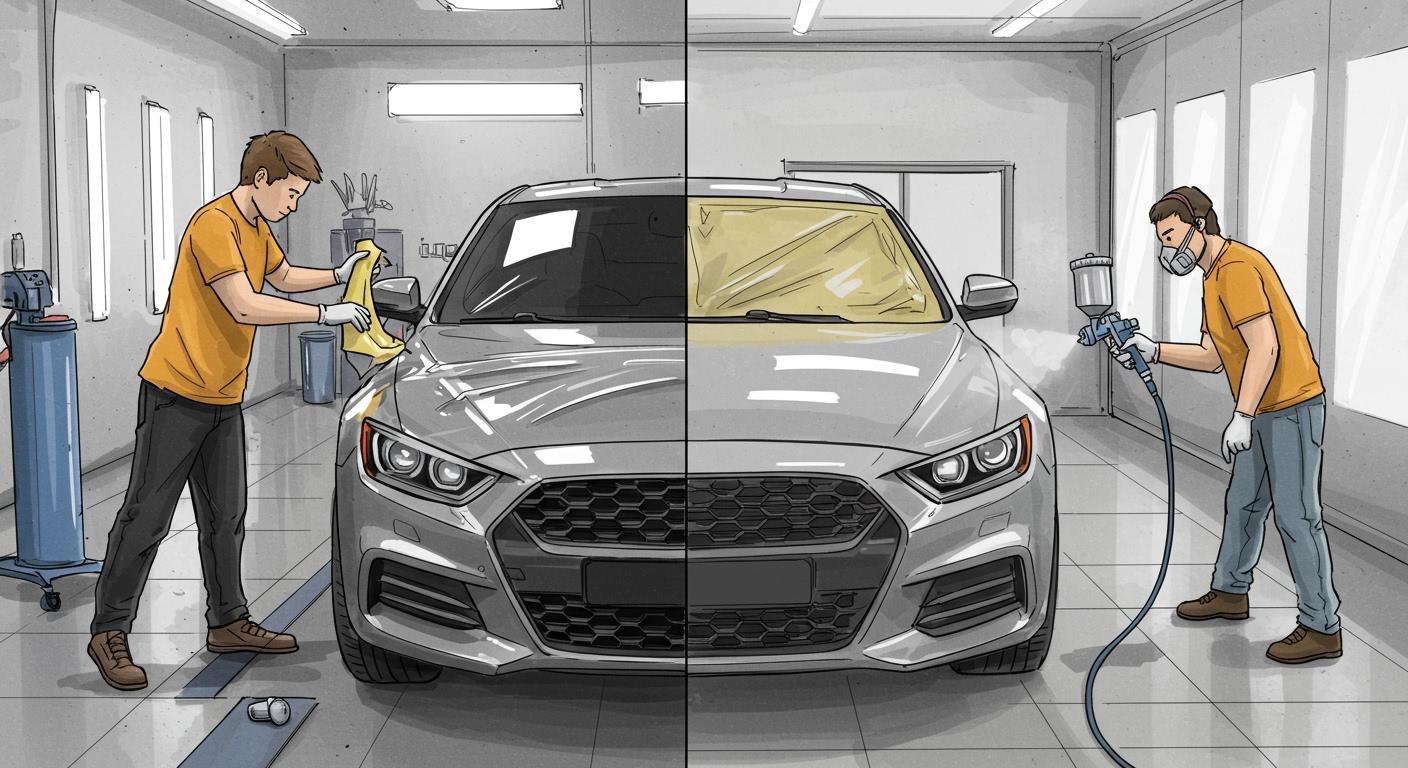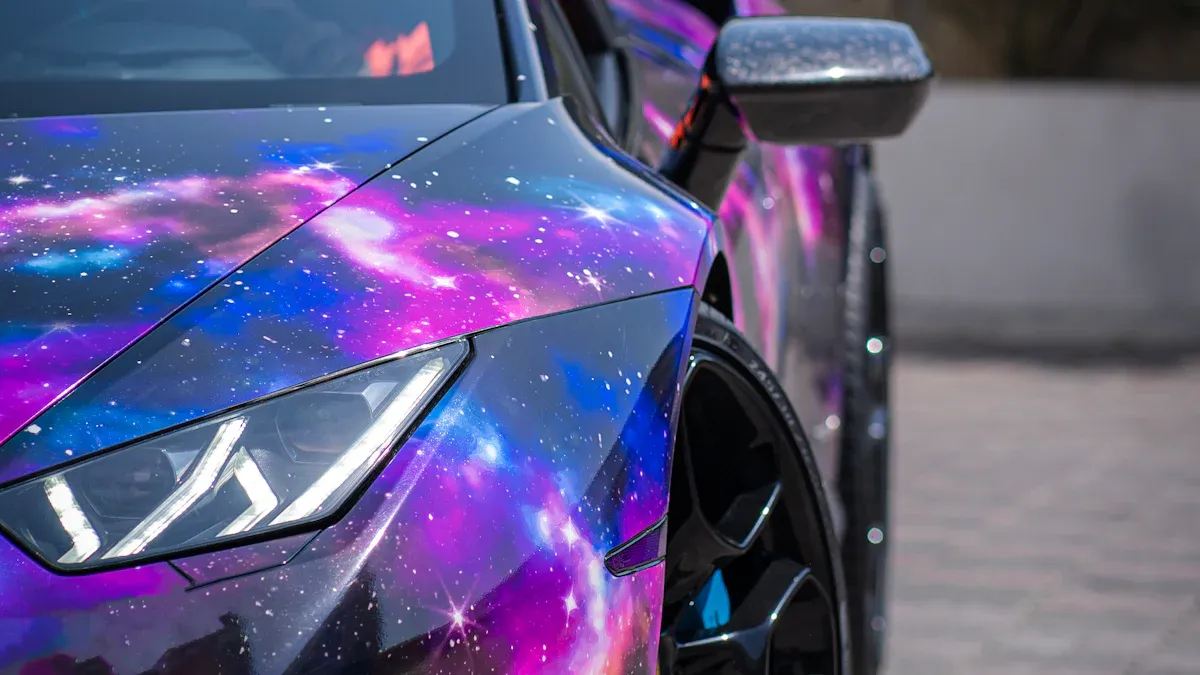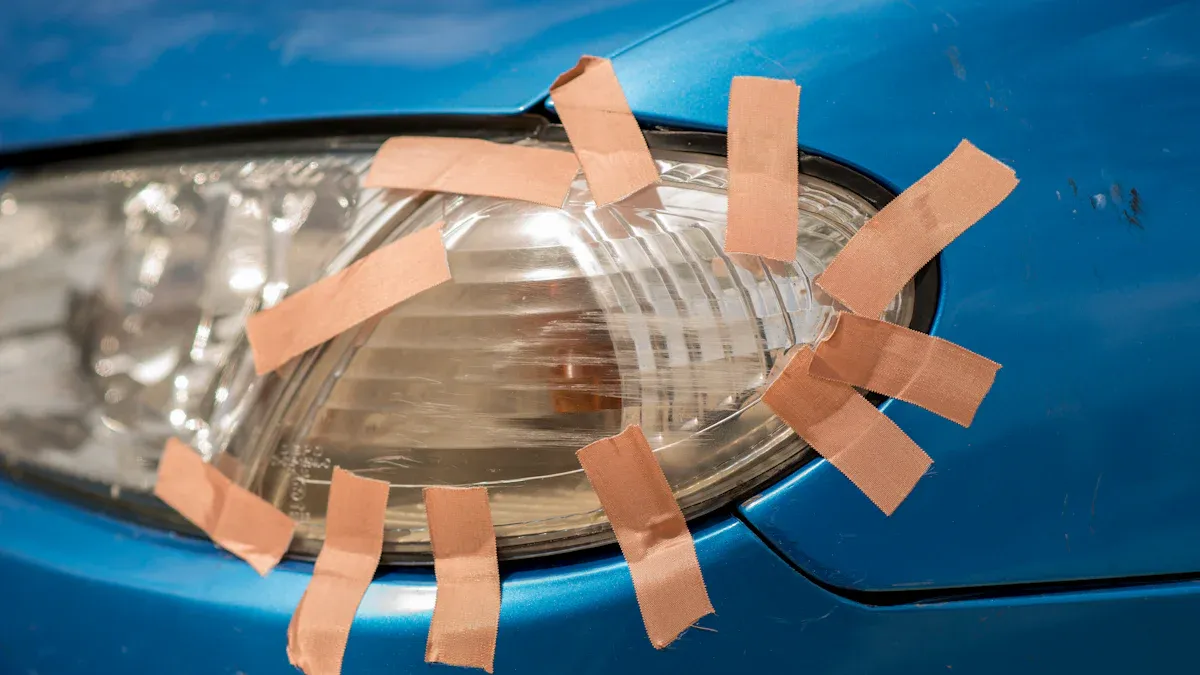
Choosing between a new car wrap or fresh paint depends on your budget and vision. Wraps offer you reversible style and protect your factory paint. Paint provides a permanent, classic finish.
Key Takeaways
- Vinyl wraps offer a quick, reversible style change. They protect your car's original paint. Wraps are often cheaper upfront than a new paint job.
- Fresh paint gives a permanent, classic look. It lasts longer than a wrap. Paint jobs cost more and take longer to complete.
- Consider your budget and how long you want the change to last. Wraps are good for temporary style. Paint is best for a long-term finish.
Cost Comparison
Money is a major factor when you decide to change your car's appearance. The price difference between a wrap and paint can be significant. Your choice affects not only your wallet today but also your expenses down the road.
Upfront Investment
Your initial payment is the first financial hurdle. A vinyl wrap is often the more budget-friendly option for a high-quality result.
- Vinyl Wrap: A professional wrap on a standard sedan typically costs you between $2,500 and $6,000. This price can climb if you choose premium materials. Specialty finishes like chrome, carbon fiber, or color-shifting films are more expensive than standard gloss or matte colors.
- Fresh Paint: A top-tier paint job gives you a factory-fresh look. However, this quality comes at a higher price. You can expect to pay from $5,000 to $15,000 or more. A show-quality finish, which involves sanding the car to bare metal, can even exceed $20,000.
Here is a quick look at how the initial costs stack up for a standard sedan:
| Service | Typical Price Range |
|---|---|
| Professional Vinyl Wrap | $2,500 - $6,000 |
| High-Quality Repaint | $5,000 - $15,000+ |
Long-Term Value
You should also consider future costs for maintenance, repairs, and eventual removal. These factors determine the true long-term value of your investment.
Repairing minor damage is one area where wraps shine. If your wrap gets a tear or scratch, a professional can often replace just the damaged panel. This process is quick and cost-effective. Repairing a paint scratch is more involved. It requires sanding, priming, and careful color matching, which can be difficult and costly, especially for the entire panel.
Another long-term cost for wraps is removal. When you are ready for a new look or want to sell the car, you must remove the vinyl.
- Professional wrap removal generally costs between $500 and $1,200.
- The price increases if the wrap is old (5+ years). Aged vinyl can crack and leave behind stubborn adhesive, requiring more labor to remove safely.
A Word of Caution 📝 Poorly maintained or old wraps can lead to expensive problems. One vehicle owner paid an extra $1,500 to have their van's paint color-sanded and buffed just to remove the glue residue left behind after a wrap removal. This was on top of the initial removal fee.
A quality paint job, on the other hand, is permanent. You will not have removal costs. Its value comes from its longevity and the classic finish it provides for years to come.
Durability and Lifespan
How long your car's new look will last is a crucial factor. Both wraps and paint have different lifespans that depend heavily on materials, installation quality, and your local environment.
Vinyl Wrap Longevity
A high-quality vinyl wrap offers a durable finish for several years. You can expect a professionally installed wrap to last between 3 to 5 years.
The biggest enemies of a vinyl wrap are environmental factors. Your wrap's lifespan can be shortened by:
- Sun Exposure: Constant, direct sunlight breaks down the vinyl with UV radiation. This causes colors to fade and can leave a chalky residue.
- Temperature Extremes: Intense heat can cause the wrap to warp or bubble. Freezing temperatures can make the vinyl brittle and prone to cracking.
- Contaminants: Airborne pollution, acid rain, and road salt can chemically react with the wrap, causing it to weaken and deteriorate faster.
Fresh Paint Longevity
A new paint job is a long-term investment in your vehicle's appearance. A factory-quality repaint can easily last 10 to 15 years or more. The longevity comes from the controlled application process and advanced materials used.
Pro Tip 💡 You can significantly extend your paint's life by adding a ceramic coating. This creates a hard, protective layer over the paint.
A ceramic coating shields your paint from UV damage, chemical stains, and environmental grime. While the coating itself lasts between 2 and 7 years depending on its quality, it keeps your paint looking vibrant and fresh underneath. This protection makes cleaning easier and defends against the elements that would otherwise degrade your car's finish.
Appearance and Customization

Your car's look is a form of self-expression. The choice between a wrap and paint heavily influences the aesthetic you can achieve. One offers limitless creativity, while the other provides timeless elegance.
The Versatility of a Car Wrap
If you want your vehicle to stand out, a car wrap gives you an incredible range of creative options. You can choose finishes that are difficult or impossible to replicate with traditional paint. Companies like Ravoony specialize in unique vinyl films with visual effects like glittering, textured, and color-shifting surfaces. Their Best Ravoony Glossy Laser Pink Car Vinyl Wrap is a good choice for people who like sparkling things.
You can explore a world of dynamic colors and textures. Some popular specialty options include:
- Color Shift Wraps: These wraps change color depending on the light and viewing angle. You can find them in matte, satin, iridescent, and dramatic chameleon finishes.
- Textured Wraps: You can get the look and feel of materials like carbon fiber. A color-shift carbon fiber car wrap even combines the woven 3D effect with a modern, dynamic color change.
- Unique Finishes: Options like pearlescent metallic, chrome, and brushed metal give your car a custom look that turns heads.
While a car wrap excels in offering unique colors and finishes, it has limitations in artistic detail. Custom airbrushed paint allows for hand-crafted designs with a depth and realism that printed vinyl cannot match.
The Classic Finish of Paint
A high-quality paint job delivers a flawless, deep gloss that many car enthusiasts covet. This "wet look" finish makes the color appear rich and liquid. Painters achieve this effect through a meticulous post-painting process.
How Painters Create a "Wet Look" 💧
- Sanding and Polishing: After painting, professionals sand the clear coat to remove any texture, known as "orange peel." They then polish the surface to a mirror shine.
- Machine Polishing: For factory paint, which has a thinner clear coat, machine polishing safely smooths the surface to enhance gloss.
- Ceramic Coating: Applying a ceramic coating is the final step. It bonds with the paint to create a hard, glassy layer that amplifies shine and protects the finish.
Paint is also the superior choice for seamless repairs. If your car gets a deep scratch or ding, a skilled technician can make the damage disappear.
The color-matching process is highly advanced:
- Scanning: A technician uses a digital tool like a spectrophotometer to scan your car's exact paint shade, accounting for any fading from sun and age.
- Formula Creation: This data helps create a custom paint formula that is a perfect match.
- Blending: The painter uses special blending and feathering techniques to apply the new paint, ensuring a seamless transition between the new and old areas.
This precision work, often done in controlled paint booths, makes repairs truly invisible.
Installation Time
The time your car spends in the shop is a major difference between a wrap and a new paint job. One gets you back on the road quickly, while the other requires significant patience.
Wrap Installation
A vinyl wrap offers a much faster turnaround. A professional shop typically takes between 1 to 5 days to complete a full vehicle wrap. The exact time depends on your vehicle's size and the design's complexity. For smaller cars with simple designs, some installers can even finish the job in a single day. You can drop your car off and have a completely new look in less than a week.
Painting Process
Painting your car is a far more involved and lengthy process. You can expect a standard paint job to take anywhere from a few days to a couple of weeks. The timeline includes several critical stages:
- Preparation: This involves extensive sanding and priming, which can take a full day or more.
- Application: The painter applies multiple layers of primer, paint, and clear coat. Each layer needs time to dry.
- Curing: This is the most crucial waiting period. Your new paint needs about 30 days to fully cure before you can apply any wax or sealant.
The Science of Curing 🔬 The curing period is when the paint truly hardens. During this time, a chemical process called cross-linking occurs, where molecules bond together to form a strong, protective layer. Properly cured paint is up to 30% more resistant to scratches, ensuring its long-term durability. Rushing this step can compromise the finish and its ability to protect your car.
Maintenance and Repairs

Proper care keeps your new look fresh, but the methods for wraps and paint are very different. Your maintenance routine will depend entirely on the finish you choose.
Caring for a Wrap
Caring for a vinyl wrap, especially a matte or textured one, requires a gentle touch. You must avoid automatic car washes with brushes, as they can scratch or lift the film's edges. Instead, always hand wash your vehicle using products designed specifically for vinyl. Using the wrong products, like wax or polish, can ruin a matte finish by creating glossy, blotchy spots.
Here are the basic rules for keeping your wrap in top condition:
| Do ✅ | Don't ❌ |
|---|---|
| Hand wash weekly | Use automatic brush washes |
| Use microfiber towels | Use wax or abrasive polish |
| Clean fuel spills immediately | Use harsh chemical cleaners |
Pro Tip 💡 When washing, you can use a pressure washer if you are careful. Keep the pressure below 1200 PSI and hold the nozzle at least one foot away from the wrap's edges to prevent lifting.
Maintaining Paint
Maintaining your car’s paint is all about protecting its deep gloss and preventing fine scratches. For regular washes, you can prevent swirl marks by following a few key steps. Always use the two-bucket method: one for soapy water and one to rinse your wash mitt. This stops you from dragging dirt back onto the car. Wash from the top down and dry gently with a clean microfiber towel.
Patience is Key for New Paint ⏳ A fresh paint job needs time to cure fully. You should wait about two weeks for the first gentle hand wash. More importantly, you must wait 60 to 90 days before applying any wax. Waxing too soon can trap solvents and damage the new finish.
Impact on Resale Value
Your car's future selling price is an important consideration. The choice between a wrap and paint can either protect or diminish its value.
How Wraps Affect Value
A high-quality vinyl wrap can be a smart move for preserving your car's resale value. It acts as a protective shield for your factory paint.
- UV Protection: The wrap blocks harmful UV rays, preventing your original paint from fading.
- Abrasion Defense: It serves as a barrier against minor scrapes and road debris, keeping the paint underneath pristine.
When you are ready to sell, you can have the wrap professionally removed. This reveals the perfectly preserved factory paint, which is a major selling point for buyers. However, you must be cautious. A poor installation or a low-quality wrap can damage the underlying paint during removal, potentially lowering your car's value.
How Paint Affects Value
A new paint job can be a double-edged sword for resale. The color you choose plays a huge role. Repainting your car to its original factory color is often the safest bet. This appeals to a wider market of potential buyers.
A Note on Color Choice 🎨 Custom paint jobs, while great for personal expression, can make your car harder to sell. A flashy or trendy design might not appeal to everyone. Even certain factory colors can affect value. Kelley Blue Book notes that black and blue cars show dirt and scratches easily, which can deter some used car buyers.
For collision repairs, matching the factory paint code is crucial. It ensures a seamless look and maintains the vehicle's value. A non-factory color can signal repairs to buyers and may require a price reduction.
Your final choice depends on your goals. A car wrap is ideal if you want reversible style, unique finishes, or to protect your original paint. Owners of exotics like Ferrari use wraps to preserve value. Choose paint for restoration, damage repair, or a permanent, high-gloss finish for the long term.
FAQ
Can you wrap a car with damaged paint?
No, you should not wrap over damaged paint. A car wrap requires a smooth surface for proper adhesion. Flaking or peeling paint will prevent the vinyl from sticking correctly.
Which is easier to clean, a wrap or paint?
Paint is generally easier to clean. You can take it through an automatic car wash. Wraps, especially matte ones, require careful hand washing to avoid damage or lifting.

















0 Comments